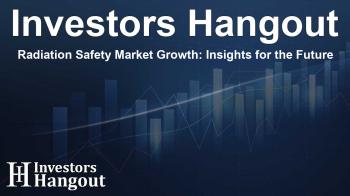Radiation Safety Market Growth: Insights for the Future

Introduction to Radiation Detection and Safety Market Growth
The global radiation detection, monitoring, and safety market is experiencing remarkable growth. Valued at approximately US$3.132 billion in 2023, experts anticipate this market will expand significantly, reaching an impressive US$5.452 billion by 2030. With a robust compound annual growth rate (CAGR) of 8.3%, this surge is propelled by increasing safety concerns surrounding radiation exposure and the implementation of stricter regulations across various industries.
Key Market Drivers
A pivotal factor leading to the market's growth is the rising awareness of radiation exposure risks. Industries such as healthcare, defense, and manufacturing are under escalating pressure to adopt advanced radiation detection solutions. As these sectors advance, regulatory bodies impose stricter compliance measures to ensure safety, which often necessitates the installation of cutting-edge radiation detection devices.
The Role of Medical Applications
In the medical field, the application of radiation has seen a surge, especially in oncology treatments. This increase mandates robust monitoring systems designed to protect both patients receiving radiation therapy and the healthcare providers administering these treatments. Consequently, as medical technology continues to evolve, the demand for advanced radiation detectors will only grow stronger, enhancing both safety and efficacy in healthcare procedures.
Defense and Homeland Security Concerns
Another significant driver for this market is the heightened apprehension regarding radiological terrorism. This concern has fueled investments in homeland security, creating a rising demand for sophisticated radiation detection systems. Such advancements are critical for ensuring safety against potential nuclear threats and unauthorized radioactive material trafficking.
Technological Innovations Shaping the Market
The market is witnessing a shift towards innovative technologies, including portable and wearable detection devices. These advancements not only facilitate easier monitoring but also integrate thoroughly with ongoing research and development in fields such as nuclear medicine and environmental health. Innovative solutions are proving effective in providing reliable detection and monitoring in a rapidly evolving landscape.
Product Segmentation Insights
The market can be segmented based on product types, which include radiation detection and monitoring systems, material monitors, and radiation monitoring software. The systems designed for radiation detection and monitoring are particularly critical, dominating market share due to their essential applications in nuclear facilities, healthcare institutions, and industrial environments. The urgent need for safety in these areas fuels the demand for advanced monitoring systems capable of detecting harmful radiation levels.
Geographic Trends in the Radiation Safety Market
Geographically, the radiation detection, monitoring, and safety market is divided into several regions. North America holds a leading position due to its stringent regulatory frameworks and advanced healthcare systems. The stringent measures enforced by regulatory agencies drive the demand for effective radiation monitoring tools to ensure compliance and protect public health.
Prominent Market Players
Major players in this market include companies like Fortive, Thermo Fisher Scientific, and Mirion Technologies. These companies are deeply invested in research and development, continually innovating to enhance radiation detection capabilities across various applications. Their extensive product portfolios feature advanced technologies that cater to the growing requirements in radiation safety, particularly in healthcare and industrial applications.
Conclusion
As awareness of radiation safety and detection grows, the market is poised for significant expansion. With projected growth figures demonstrating a clear trend towards greater investment in safety and monitoring systems, organizations across industries must prioritize integrating these technologies. The future of the radiation detection, monitoring, and safety market looks bright, promising continued advancements and a commitment to safeguarding individuals and facilities from radiation risks.
Frequently Asked Questions
What is the expected growth rate of the radiation safety market?
The radiation detection, monitoring, and safety market is expected to grow at a CAGR of 8.3% through 2030.
Why is there an increased demand for radiation detection systems?
The demand is driven by heightened safety concerns, regulatory requirements, and advancements in medical applications.
Which sectors are primarily driving market growth?
Key sectors include healthcare, defense, and industrial applications, all requiring stringent radiation safety measures.
Are there technological advancements in the radiation detection market?
Yes, innovations include portable and wearable detection devices that improve monitoring efficiency and accuracy.
Who are the major players in the radiation safety market?
Notable companies include Fortive, Thermo Fisher Scientific, and Mirion Technologies, known for their robust R&D in radiation safety technologies.
About The Author
Contact Ryan Hughes privately here. Or send an email with ATTN: Ryan Hughes as the subject to contact@investorshangout.com.
About Investors Hangout
Investors Hangout is a leading online stock forum for financial discussion and learning, offering a wide range of free tools and resources. It draws in traders of all levels, who exchange market knowledge, investigate trading tactics, and keep an eye on industry developments in real time. Featuring financial articles, stock message boards, quotes, charts, company profiles, and live news updates. Through cooperative learning and a wealth of informational resources, it helps users from novices creating their first portfolios to experts honing their techniques. Join Investors Hangout today: https://investorshangout.com/
The content of this article is based on factual, publicly available information and does not represent legal, financial, or investment advice. Investors Hangout does not offer financial advice, and the author is not a licensed financial advisor. Consult a qualified advisor before making any financial or investment decisions based on this article. This article should not be considered advice to purchase, sell, or hold any securities or other investments. If any of the material provided here is inaccurate, please contact us for corrections.

